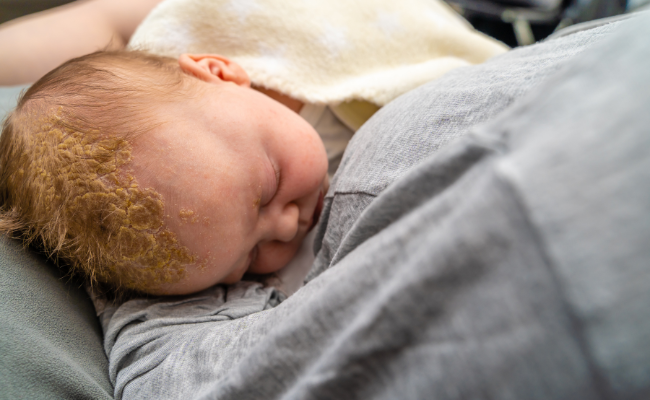How to Treat Cradle Cap?
- December 13, 2023
- No Comments

What is Cradle Cap?
Cradle cap, also known as seborrheic dermatitis or infantile seborrheic dermatitis, is a common and generally harmless skin condition affecting infants. It presents as greasy, yellowish, and scaly patches on the baby's scalp, often accompanied by a rash, causing concern for parents due to its unsightly appearance. Although cradle cap does not pose a threat to the baby's health, it typically resolves on its own within a few weeks or months.
This prevalent condition commonly occurs within the first three months after birth, with the majority of cases emerging during the baby's inaugural year. While it usually clears up by the time the infant reaches their first birthday, a small percentage of babies may experience cradle cap at 1 or 2 years of age. Most cases are mild, requiring no specific treatment, but consulting a pediatrician is advisable for any parental concerns. Addressing cradle cap is primarily driven by cosmetic considerations rather than being a necessity for the baby's health and comfort.
Why Does Cradle Cap Occur?
The exact cause of cradle cap is not fully understood, but it is believed to be related to the overproduction of sebum, the oily substance produced by the skin. In infants, the sebaceous glands may be more active, leading to an accumulation of sebum on the scalp. Additionally, a common yeast called Malassezia may play a role in the development of cradle cap. Hormones passed from the mother to the baby during childbirth could also contribute to the condition.
How to Identify Cradle Cap?
Cradle cap is easily recognizable by the distinctive appearance of the affected area. The scalp may have oily, yellow or brown scales or crusts that can be somewhat greasy to the touch. In some cases, cradle cap can also affect other areas of the body, such as the face, neck, and diaper area. While cradle cap is generally not itchy or uncomfortable for the baby, parents may be concerned about its appearance.
Treatment Solutions for Cradle Cap
- Gentle Shampooing: The first line of defense against cradle cap involves keeping the baby's scalp clean. Gently wash the baby's hair with a mild baby shampoo. It's essential to be gentle during the washing process to avoid irritating the delicate skin on the scalp.
- Brushing the Scalp: Using a soft baby brush or a fine-toothed comb can help loosen and remove the scales from the scalp. This should be done very gently to avoid causing any discomfort to the baby. Brushing the scalp can also stimulate the natural oils, helping to reduce the severity of cradle cap.
- Oil Application: Applying a natural oil, such as coconut oil or olive oil, to the affected area can help soften the scales, making them easier to remove. Allow the oil to sit on the scalp for a short period before gently brushing or combing the scales away.
- Avoiding Harsh Products: It's crucial to avoid using harsh or medicated shampoos on an infant's delicate scalp. These products can be too strong for the baby's skin and may exacerbate the condition. Stick to gentle, baby-friendly products to cleanse the scalp.
- Regular Cleaning Routine: Establishing a regular cleaning routine can help manage cradle cap. Washing the baby's hair regularly, but not too frequently, and gently brushing the scalp can prevent the scales from accumulating.
Benefits of Treating Cradle Cap
- Improved Aesthetic Appearance: Treating cradle cap helps improve the aesthetic appearance of the baby's scalp. The removal of scales and crusts can make the skin look healthier and cleaner, providing a more pleasant visual experience for parents.
- Prevention of Complications: While cradle cap is generally harmless, untreated cases may lead to complications such as bacterial infections. Regular cleaning and treatment can prevent these complications and ensure the baby's skin remains healthy.
- Enhanced Comfort for the Baby: The presence of scales on the scalp may cause discomfort or itching for the baby. By addressing cradle cap, parents can contribute to the overall comfort and well-being of their infant.
- Establishing Healthy Skin Care Habits: Early intervention for cradle cap sets the foundation for healthy skin care habits. Parents can learn to recognize and address minor skin conditions, promoting a proactive approach to infant care.
- Reduced Parental Anxiety: Dealing with an infant's skin condition can be stressful for parents. Treating cradle cap effectively reduces parental anxiety, providing reassurance that the condition is manageable and temporary.
Comments (0)